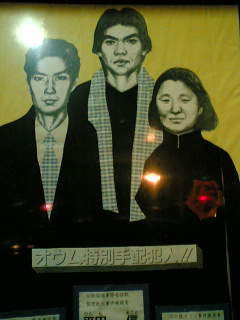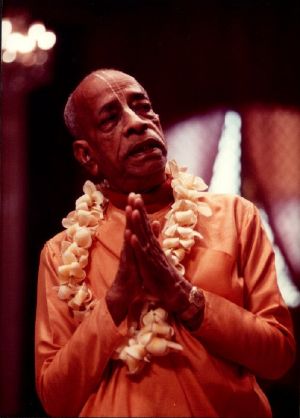Cult
A cult strictly speaking, is a particular system of religious worship, especially with reference to its rites and ceremonies. Used in a more pejorative sense, cult refers to a cohesive social group, usually of a religious believers, which the surrounding society considers outside the mainstream or possibly dangerous. In Europe, the term "sect" is often used to describe "cults" in this sense.
During the twentieth century groups referred to as "cults" or "sects" by governments and media became globally controversial. The rise and fall of several groups known for mass suicide and murder tarred hundreds of new religious groups of various characters, some arguably quite benign.
Controversy exists among sociologists of religion as to whether the term "cult" should be abandoned in favor of the more neutral "new religious movement." A great deal of literature has been produced on the subject, the objectivity of which is hotly debated.
Definitions
The literal and traditional meaning of the word cult is derived from the Latin cultus, meaning "care" or "adoration." Sociologists and historians of religion speak of the "cult" of the Virgin Mary or other traditions of worship in a neutral sense.
With regard to the more negative meaning of the term, most religions start out as "cults" or sects, i.e. relatively small groups in high tension with the surrounding society. For example, Christianity was originally a sect within Judaism and the Roman Empire which faced difficulties because of its belief in Jesus as the Messiah and its rejection of Roman pagan tradition. Over time, such groups tend either die to out or become more established and in less tension with society.[1]
Due to popular connotations of the term "cult," many academic researchers of religion and sociology prefer to use the term new religious movement (NRM). Such new religions are usually started by charismatic but unpredictable leaders. If they survive past the first or second generation, they tend to institutionalize, become more stable, find a greater degree of acceptance in society, and sometimes become the mainstream or even dominant religious group.
Controversies about "cults"
By one measure, between 3,000 and 5,000 purported "cults" existed in the United States in 1995.[2] Anti-cultists in the 1970s and 1980s made particularly strong accusations regarding the danger of cults for members, "brainwashing," the separation of "cult" members from their families, and potential harm to the larger society. This led to the so-called "deprogramming" controversy, in which hundreds of young adults were forcibly kidnapped and held against their wills by paid agents of their parents in an effort to get them to renounce their groups. Media sensationalism fueled the controversy, as did court battles which pitted experts witnesses against each other in such fields as sociology and psychology. Meanwhile relatively harmless groups found themselves associated with the violent self destructive "cult" actions in which they had no part.
Certain groups that have been characterized as cults have clearly posed a threat to the well-being and lives of their own members and to society in general. For example, the mass suicide of over 900 People's Temple members on November 18, 1978 led to increased concern about "cults." The Sarin gas attack on the Tokyo subway in 1995, carried out by members of Aum Shinrikyo, renewed this concern, as did several other violent acts—both self-destructive and against others—by other groups. The number of violently destructive groups, however, is extremely small compared with the literally tens of thousands of new religious movements which are estimated to exist.[3]
Some groups, while not universally condemned, remain suspect to the general public. Examples include Scientology, the Unification Church, and the Hare Krishnas. Each of these groups is now well into its second or third generation, and it is often difficult to distinguish between a group's public image (which may have become fixed decades earlier) and its current practices. Earlier "cults," such as the [[Mormon Church|Mormons[[, Jehovah's Witnesses, Seventh Day Adventists, and Christian Scientists, are now generally considered part of the mainstream religious fabric of the American society in which they originated.
Although the majority of "cults" are religious in nature, a small number of non-religious groups are classified as as "cults" by their opponents. These may include political, psychotherapeutic or marketing groups. The term has also been applied to certain human-potential and self-improvement organizations.
Stigmatization and discrimination
Because of the increasingly pejorative use of the terms "cult" over recent decades, many argue that these terms are to be avoided.
Researcher Amy Ryan has argued for the need to differentiate those groups that may be dangerous from groups that are more benign.[4] Ryan notes the sharp differences between definition from cult opponents, who tend to focus on negative characteristics, and sociologists, who aim to create definitions that are value-free.
These definitions have political and ethical impact beyond just scholarly debate. In "Defining Religion in American Law," Washington DC attorney Bruce J. Casino presents the issue as crucial to international human rights laws. Limiting the definition of religion may interfere with freedom of religion, while too broad a definition may give some dangerous or abusive groups "a limitless excuse for avoiding all unwanted legal obligations."[5]
In 1999, the Maryland State Task Force to Study the Effects of Cult Activities on Public Senior Higher Education Institutions admitted in its final report that it had "decided not to attempt to define the world 'cult'" and proceeded to avoid the word entirely in its final report, except in its title and introduction.[6]
Leaving a "cult"
A major contention of the anti-cult movement in the 1970s had been that "cult members" had lost their ability to choose and only rarely left their groups without "deprogramming." In fact, there are at least three ways people leave a new religious movement. These are 1) by their own decision, 2) through expulsion, and 3) by intervention (Exit counseling or deprogramming).
Most authors agree that some people experience problems after leaving a "cult." These include negative reactions in the individual leaving the group as well as negative responses from the group such as shunning. There are disagreements regarding the degree and frequency of such problems, however, and regarding the cause.
Eileen Barker (1989) mentions that some former members may not take new initiatives for quite a long time after disaffiliation from the NRM. However, she also points out that leaving is not nearly so difficult as imagined. Indeed, as many as 90 percent of those who join a high intensity group ultimately decide to leave.[7]
Exit Counselor Carol Giambalvo believes most people leaving a cult have associated psychological problems, such as feelings of guilt or shame, depression, feeling of inadequacy, or fear, that are independent of their manner of leaving the cult.[8] However, sociologists David Bromley and Jerffrey Hadden note a lack of empirical support for alleged consequences of having been a member of a cult or sect, and substantial empirical evidence against it. These include the fact that the a large proportion of people who get involved in NRMs leave, most short of two years; the overwhelming proportion of those who leave do so of their own volition; and that 67 percent felt "wiser for the experience."[9]
Criticism by former members
The role of former members in the controversy surrounding cults has been widely studied by social scientists. Former members in some cases become public opponents against their former group. The former members' motivations, the roles they play in the anti-cult movement, and the validity of their testimony, are controversial. Scholars suspect that at least some of their narratives are colored by a need of self-justification, seeking to reconstruct their own past, and to excuse their former affiliations, while blaming those who were formerly their closest associates.
Moreover, although some cases of abuse are incontrovertible, hostile ex-members have been shown to shade the truth and blow out of proportion minor incidents, turning them into major abuses.[10] Sociologist and legal scholar James T. Richardson contends that because there are a large number of NRMs and tendency exists to make unjustified generalizations about them, based on a select sample of observations of life in such groups or the testimonies of (ex-)members.[11]
Governments and "cults"
Some governments have taken restrictive measures against "sects," especially France and Germany. The 2004 annual report by the United States Commission on International Religious Freedom states that these initiatives have "...fueled an atmosphere of intolerance toward members of minority religions in France." The U.S. State Department has criticized both France and Germany for repressive measures against "sects."
Regarding the U.S. itself, it has been argued that the "brainwashing" theory promulgated by the anti-cult movement contributed to U.S. actions leading to the deaths of close to 100 members of the Branch Davidian group in Waco, Texas.[12] It has also been alleged that negative perceptions of a group by prosecutors was a factor in the income tax case against Reverend Sun Myung Moon, which resulted in his serving more than a year in prison in the mid 1980s.[13]
See also
Notes
- ↑ Stark, 1996
- ↑ Singer, 2003.
- ↑ Barker, 1984
- ↑ Ryan, Amy "New Religions and the Anti-Cult Movement". rand.pratt.edu Retrieved July 22, 2008.
- ↑ Casino, Bruce J., "Defining Religion in American Law". www.religiousfreedom.com. Retrieved July 22, 2008.
- ↑ Task Force Exectutive Summary. www.religiousfreedom.com. Retrieved July 22, 2008.
- ↑ Barker, 1983.
- ↑ Giambalvo, Carol. "Post-cult problems". www.csj.org. Retrieved July 22, 2008.
- ↑ Bromply and Hadden, 1993, pp. 75-97.
- ↑ Melton, Gordon. "Brainwashing and the Cults: The Rise and Fall of a Theory". www.cesnur.org.Retrieved July 22, 2008.
- ↑ Richardson, James T. "The Psychology of Induction: A Review and Interpretation," Marc Galanter, ed., Cults and new religious movements, 1989. American Psychological Assn. ISBN 0890422125
- ↑ Anthony, D., Robbins, T., Barrie-Anthony, S. "Cult and Anticult Totalism: Reciprocal Escalation and Violence." Terrorism and Political Violence, Spring 2002, pp. 211-240.
- ↑ Sherwood, 1991
Bibliography
Books
- Barker, Eileen. Barker, Eileen. The Making of a Moonie: Choice or Brainwashing? Oxford: B. Blackwell, 1984. ISBN 9780631132462
- ______________New Religious Movements: A Practical Introduction. London: H.M.S.O., 1989. ISBN 9780113409273
- Bromley, David G., and Jeffrey K. Hadden. The Handbook on Cults and Sects in America. Religion and the social order, v. 3. Greenwich, Conn: JAI Press, 1993. ISBN 9781559387156
- Bromley, David G., and J. Gordon Melton. Cults, Religion, and Violence. Cambridge: Cambridge University Press, 2002. ISBN 0521668980
- Lalich, Janja. Bounded Choice: True Believers and Charismatic Cults. Berkeley: University of California Press, 2004. ISBN 0520240189
- Melton J. Gordon. Encyclopedic Handbook of Cults in America. Religious information systems series, vol. 7. New York: Garland Pub, 1992. ISBN 0815311400
- Sherwood, Carlton. Inquisition: The Persecution and Prosecution of the Reverend Sun Myung Moon. Washington, D.C.: Regnery, 1991. ISBN 089526532X
- Singer, Margaret Thaler. Cults in Our Midst. San Francisco, CA: Jossey-Bass, 2003. ISBN 0787967416
- Stark, Rodney, and William Sims Bainbridge. A Theory of Religion. New Brunswick, N.J.: Rutgers University Press, 1996. ISBN 9780813523309
- Tourish, Dennis, and Tim Wohlforth. On the Edge: Political Cults Right and Left. Armonk, N.Y.: M.E. Sharpe, 2000. ISBN 0765606399
- Zablocki, Benjamin David, and Thomas Robbins. Misunderstanding Cults: Searching for Objectivity in a Controversial Field. Toronto: University of Toronto Press, 2001. ISBN 0802081886
External links
- Apologetics Index. www.apologeticsindex.org
- Center for Studies on New Religions. www.cesnur.org
- Cult Awareness Network. www.cultawarenessnetwork.org
- International Cultic Studies Association. www.csj.org
- Ontario Consultants on Religious Tolerance. www.religioustolerance.org
- University of Virginia Religious Movements Homepage. www.virginia.edu
Credits
New World Encyclopedia writers and editors rewrote and completed the Wikipedia article in accordance with New World Encyclopedia standards. This article abides by terms of the Creative Commons CC-by-sa 3.0 License (CC-by-sa), which may be used and disseminated with proper attribution. Credit is due under the terms of this license that can reference both the New World Encyclopedia contributors and the selfless volunteer contributors of the Wikimedia Foundation. To cite this article click here for a list of acceptable citing formats.The history of earlier contributions by wikipedians is accessible to researchers here:
The history of this article since it was imported to New World Encyclopedia:
Note: Some restrictions may apply to use of individual images which are separately licensed.



